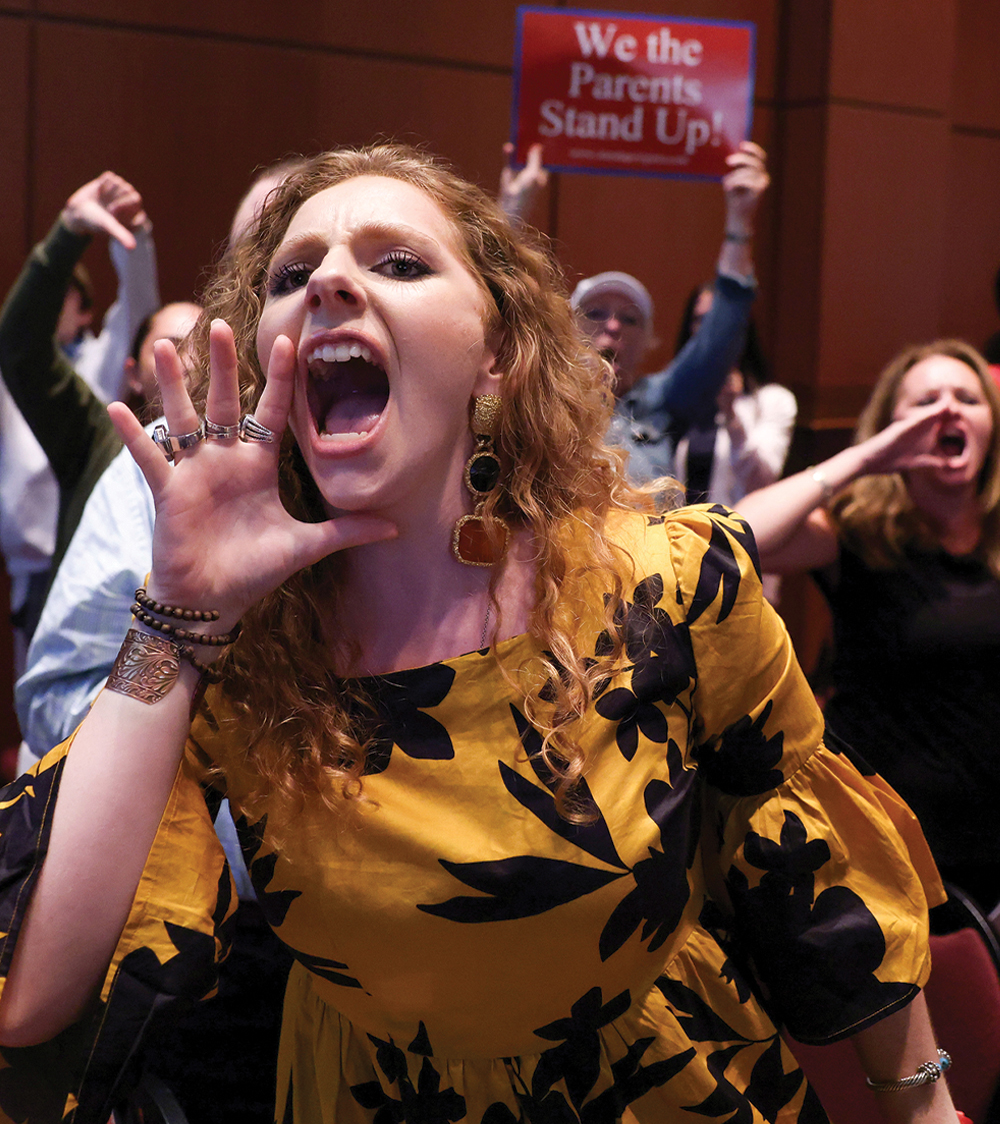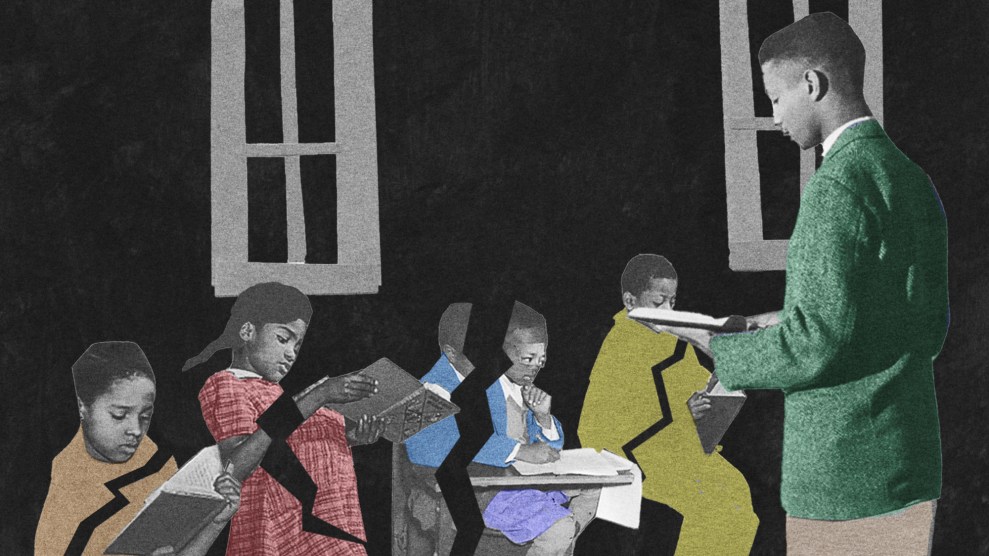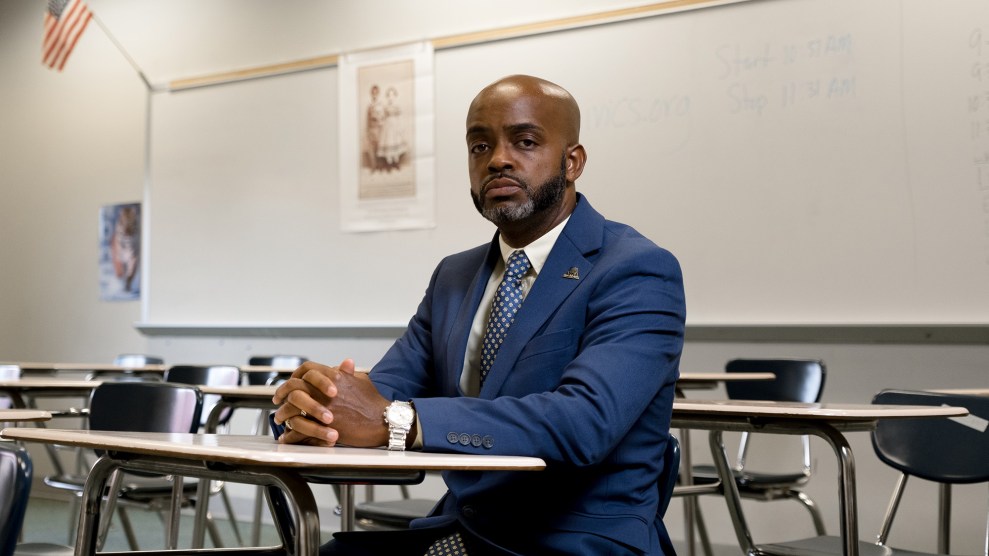At raucous school board meetings across the country, disgruntled parents have grabbed the mic to represent the political desires of the Republican Party. Once-innocuous local gatherings have become anti–critical race theory caucuses administered by white people.
In July 2021, the Missouri state legislature’s joint education committee held an invite-only hearing on how educators in public K–12 schools teach about racism. “I felt today it was important to hear from people who have tried to go through the official cycle of authority within their districts and have basically been turned away,” said Cindy O’Laughlin, a Republican senator and the committee’s chair. For O’Laughlin, “people” has a precise meaning, as no Black person spoke and the only people allowed to give testimony were opponents of critical race theory. Of course, giving primacy to white speakers has a history far older than CRT. As an 1804 Missouri law said, “no negro or mulatto shall be a witness except in the pleas of the United States against negroes or mulattoes or in civil pleas where negroes alone shall be parties.”
The parallels did not go unnoticed. “It is the height of irony that a hearing to consider censoring curriculum would censor those who are allowed to speak,” said Ingrid Burnett, a Democratic representative from Kansas City who pointed out the hearing’s one-sidedness.
As even the state’s Republican governor noted on social media the day after the meeting, there’s no evidence that CRT, an academic framework for analyzing how racism is embedded in American law and culture, is being taught throughout Missouri. There is certainly no evidence, as O’Laughlin advanced, that local authorities have stymied its opponents. CRT “has no business being taught in Missouri classrooms—but the vast majority of our schools are not doing that,” Gov. Mike Parson wrote. He later elaborated, “Look, the only way critical race theory can be taught in a school—the only way—is if the locals let it happen. That’s controlled by the local school boards.” In short, Parson argued that the system already works for conservatives. Indeed, out of more than 400 districts, the Missouri Board of Education has identified only one with CRT in the curriculum: Kansas City, where 54 percent of students are Black.
But most Missouri districts have starkly different demographics and are represented by local officials who reflect the wishes and anxieties of white people. O’Laughlin lives in Shelby County, where roughly 95 percent of residents and students are white, and which Trump won with 80 percent of the vote. Even in more diverse communities, school boards, thanks partly to decades of attention from conservative activists, lean right. A 2018 Vanderbilt study using data from Ohio showed that school board members are generally “more likely to come from wealthier, whiter, and better educated neighborhoods”—trends that advantage the GOP.
As Missouri’s 1804 law privileging white testimony shows, those advantages are rooted in history—and can be found nationwide. Take Connecticut, where, in 1833, the general assembly enacted the “Black Law,” which prohibited anyone from establishing an institution for the “education of colored persons…without the consent, in writing, first obtained of a majority of the civil authority, and also of the select men of the town.”
That law enshrining local control was passed in response to abolitionist Prudence Crandall’s move to turn the school she ran into one “for young ladies and little misses of color.” Until she admitted 20-year-old African American Sarah Harris Fayerweather, Crandall’s all-white Canterbury Female Boarding School was esteemed by the town.
Fayerweather, considered the first African American to enroll in a white school, was known as a churchgoing young woman of high character. But when she sought admission, Crandall hesitated, knowing the backlash it would bring. Many of her pupils’ parents were members of the American Colonization Society, an organization that wanted to send Black Americans to Africa to settle Liberia—parents who, as abolitionist Samuel May wrote, “would not have it said that their daughters went to school with a nigger girl.”
But Crandall, a Quaker, came from an anti-slavery family. (In 1835, her younger brother, Reuben, would be prosecuted for possessing abolitionist literature and contracted a fatal case of tuberculosis while jailed.) She also believed in the power of education and was moved by Fayerweather’s plan to become a teacher in her own community. After Fayerweather enrolled, the school made a quick shift in course, taking out an ad in the Liberator, the nation’s abolitionist paper of record, spreading word that it would exclusively serve young Black women—and seeking applicants from all corners.
A week later, a town meeting was convened where Crandall’s new project was denounced. At the vanguard was Andrew Judson, an officer of the American Colonization Society, a member of the Connecticut House of Representatives, and a man of good standing in the anti-Black community. Judson was incensed at the idea of a “school for nigger girls” and insisted “there shall not be such a school set up anywhere in the State.” That opinion was widely voiced at the meeting, which barred Crandall’s few supporters from speaking. A series of resolutions against Crandall passed, warning that the school would result in “incalculable evils” and letting her know that the reimagined institution “meets with our unqualified disapprobation, and it is to be understood, that the inhabitants of Canterbury protest against it, in the most earnest manner.” A committee was formed to convince Crandall of the “injurious consequences that would inevitably result from the introduction of colored children into the town,” as abolitionist Henry Benson, who attended the meeting, wrote in the Liberator. He summarized the crowd’s objection: “Her unpardonable sin lay altogether in her wish to elevate the moral and intellectual condition of the blacks, and attempting to carry her plans into operation, without consulting them.” The Black Law soon gave the town’s sentiment teeth, nominally entrusting it and all other Connecticut localities with the power to ban such schools.
This is the “local control” that Gov. Parson favors, where a “select” group is given legal authority to rebuke the evils they are convinced critical race theory will impart on white society. Throughout history, the “unpardonable sin” of educators moving toward racial progress without white consent has been atoned for in the same way: disgruntled white people band together on a school board or committee to erase unwanted Black people, texts, and consciousness. Today, it is happening even where CRT cannot be found but where attacks on it hang like a specter. Texas school librarians have pulled books by Black authors, hoping to preempt controversy after legislators assembled a list of titles they sought to ban; a Black principal there was fired by his school board after pushing back against false accusations he had promoted CRT. In January, Florida lawmakers backed by GOP Gov. Ron DeSantis advanced a bill outlawing lessons that might make students feel “guilt” or “discomfort” about their race.
Recent polls show that Black parents are far more receptive to the teaching of the tenets of critical race theory than white parents. But across the country, parents in favor of interrogating America’s racial history have been disregarded. “It seems as though Black and Brown voices were ignored, and the voices were centered on White parents and their concerns,” Rakelle Mullenix, a Black mother of two in Annandale, Virginia, told the Washington Post for an article on how the debate over teaching racial injustice powered Republican Gov. Glenn Youngkin’s 2021 election. “I’m constantly hearing, ‘Oh, no, suburban women, suburban moms and their vote.’ And when I look around me and see these suburban moms and housewives, a lot of them look like me. But when I hear the conversations on the news, it doesn’t sound like they’re talking about me.” (Youngkin’s first executive order tasked education officials with rooting out CRT and other “inherently divisive concepts.”)
Despite the town’s opposition, Crandall’s school went ahead and enrolled more than 15 Black girls from Boston, Philadelphia, and Providence. Store owners refused to sell Crandall and her students food, clothing, and supplies. The well near Crandall’s house was filled with manure, her house battered with stones and rotten eggs. Citizens of Canterbury made attempts to prosecute Crandall’s teenage students using an obsolete 1750 vagrancy law that threatened whipping and weekly fines. One 17-year-old student was arrested after receiving a warning; wealthy Crandall supporters responded by bankrolling a $10,000 fund to fight such arrests, preventing Canterbury’s authorities from punishing the students.
Crandall was arrested and tried twice under the new Black Law. In the first trial, the jurors could not agree to convict her even though the presiding judge endorsed the law as “constitutional and obligatory on the people of the state.” A second before the state’s Supreme Court was dismissed on a technicality. But legal success offered no protection. After a failed attempt to burn down Crandall’s house, her windows were smashed. For safety, supporters told Crandall to abandon her mission. The school closed in September 1834.
As a local historian later wrote, “If the Canterbury people had quietly accepted the situation and left them in peace the difficulty would soon have ended.” But the town’s racists would not quietly acquiesce to anti-racist education. What animates much of today’s white backlash to critical race theory is the same germ that caused anxiety over Black education in Canterbury. And formal bans on CRT or similar anti-racist teachings—now law in eight states—have again created an environment of intimidation. As Crandall’s loss and similar indignities targeting today’s educators show, that force can have a power even greater than law.

















